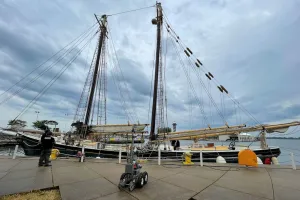
With the threat of violence today, TSA is at the ready … even on the water!
TSA explosives experts from Pittsburgh helped organize a unique maritime bomb drill on Lake Erie in Pennsylvania. The explosives specialists partnered with several agencies to prepare for a possible bombing incident, including a suicide bomber.
While the U.S. has not experienced many suicide bombing incidents, John Hartt, Lead Pittsburgh International Airport transportation security specialist for explosives (TSSE), said we need to be prepared.
“Our thought process is to continually train and prepare for every type of possible explosive event,” Hartt said. “This helps keep the bomb squads fresh and prepared for whatever scenario they encounter.”
For this exercise earlier this month, TSA teamed with the Erie Bomb Squad, Customs and Border Protection Air and Marine, and Valentis Group, which oversees security for Tall Ships America, the largest sail training association in the world.
After using a robot to make initial contact, responders boarded a docked 129-year-old tall wooden ship named Lettie G. Howard and responded to a mock bombing incident on the 53-foot vessel Jo-Ann M in Presque Isle Bay, a part of Lake Erie.
Not only was the drill designed to strengthen their overall readiness, the overarching goal was to help prepare the Erie Bomb Squad for the Erie Tall Ships festival, a four-day maritime celebration in late August, which 65,000 people are expected to attend.
“Drills like this introduce bomb technicians to the unique challenges of transportation environments through a series of realistic practical exercises,” Hartt assessed. “It’s designed to identify and resolve potential problems before they manifest themselves during actual emergency situations. In this situation, we were trying to be proactive before the Erie Tall Ships event.”
TSA Pittsburgh also partnered with the Erie Maritime Museum, which provided access to Lettie G. Howard, the Flagship Niagara League, which allowed exercise participants to use the ship, and At The Lake Ministries, which offered use of their boat for the training.
Hartt said exercises like this require a significant amount of planning.
“We create [transportation-related bomb squad responses] every year for our local bomb squads,” he noted. “We try to identify a need or opportunity for training, imagine different scenarios, spend months coordinating with all of the different players and event/property hosts, and finally put it all together.”
Hartt believes his team and TSA’s partners learned several good lessons from this maritime exercise, including how to work in small, tight environments. He said the bomb squads realized they forgot an important piece of equipment when boarding one of the boats anchored in the bay, forcing them to quickly adapt.
“You can’t just stop a real life event and go back and get [your equipment],” Hartt emphasized. “So, what do you do? It made them think and improvise and try different techniques than normal. I also think training increases when you have outside thoughts, ideas and experiences than just the same ones you work with every day.”
Pittsburgh region TSA Federal Security Director Karen Keys-Turner offered her appreciation for TSA Pennsylvania’s leadership in these types of key transportation security efforts.
“I would like to acknowledge the Pittsburgh TSSE team for sharing their expertise to support advance security exercises to facilitate security at the upcoming Erie Tall Ships event,” said Keys-Turner. “The advance engagement of the Pittsburgh TSSE team, in conjunction with the on-site support of the Philadelphia International Airport Visible Intermodal Prevention and Response team, will facilitate the ability of local law enforcement to secure the Tall Ships festivities.”
Hartt said his Pittsburgh explosives team tries to conduct a bomb training exercise every year and has another one planned in August at John Murtha Johnstown–Cambria County Airport in Johnstown, Pennsylvania.
“We’re excited to keep offering training to all of our local bomb squads, with the hope they are learning and continuing to find it helpful.”
By Don Wagner, TSA Strategic Communications & Public Affairs


